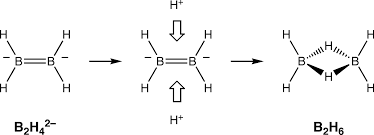
(A)Chlorine is more electronegative than hydrogen
(B)There is pπ– pπ back bonding in
(C)Large sized chlorine atoms do not fit in between the small boron atoms whereas small-sized hydrogen atoms get fitted in between boron atoms
(D)None of the above
Answer
147k+ views
Hint: The dimerisation is due to the unstable structure of
Complete step by step solution:
Chlorine is a group 17 element whereas, Boron is a group 13 element Thus the size of boron is much much less than the size of the chlorine.
So if we try to make B2Cl6 it is not possible for this compound to be stable but diborane(B2H6) can form since hydrogen is a very very smaller atom than chlorine. If there is the bonding between two atoms where one atom is having one vacant orbital and another is having one lone pair of electrons, then if this electron pair is donated to that respective vacant orbital then the bonding is called pπ– pπ or pπ– dπ depending on the orbital to which the electron pair is donated and from which the electron pair is donated.
The bonding between the boron atoms and the bridging hydrogen atoms is, however, different from that in molecules such as hydrocarbons. Each boron uses two electrons in bonding to the terminal hydrogen atoms and has one valence electron remaining for additional bonding. The bridging hydrogen atoms provide one electron with each. The B2H2 ring is held together by four electrons which form two 3-centre 2-electron bonds. This type of bond is sometimes called a 'banana bond'.

The answer is option (C).
Note:/b<> There is no relation of electronegativity or back bonding for dimerisation of
Complete step by step solution:
Chlorine is a group 17 element whereas, Boron is a group 13 element Thus the size of boron is much much less than the size of the chlorine.
So if we try to make B2Cl6 it is not possible for this compound to be stable but diborane(B2H6) can form since hydrogen is a very very smaller atom than chlorine. If there is the bonding between two atoms where one atom is having one vacant orbital and another is having one lone pair of electrons, then if this electron pair is donated to that respective vacant orbital then the bonding is called pπ– pπ or pπ– dπ depending on the orbital to which the electron pair is donated and from which the electron pair is donated.
The bonding between the boron atoms and the bridging hydrogen atoms is, however, different from that in molecules such as hydrocarbons. Each boron uses two electrons in bonding to the terminal hydrogen atoms and has one valence electron remaining for additional bonding. The bridging hydrogen atoms provide one electron with each. The B2H2 ring is held together by four electrons which form two 3-centre 2-electron bonds. This type of bond is sometimes called a 'banana bond'.

The answer is option (C).
Note:/b<> There is no relation of electronegativity or back bonding for dimerisation of
Latest Vedantu courses for you
Grade 11 Science PCM | CBSE | SCHOOL | English
CBSE (2025-26)
School Full course for CBSE students
₹41,848 per year
EMI starts from ₹3,487.34 per month
Recently Updated Pages
How to find Oxidation Number - Important Concepts for JEE

How Electromagnetic Waves are Formed - Important Concepts for JEE

Electrical Resistance - Important Concepts and Tips for JEE

Average Atomic Mass - Important Concepts and Tips for JEE

Chemical Equation - Important Concepts and Tips for JEE

Concept of CP and CV of Gas - Important Concepts and Tips for JEE

Trending doubts
JEE Main 2025 Session 2: Application Form (Out), Exam Dates (Released), Eligibility, & More

JEE Main Exam Marking Scheme: Detailed Breakdown of Marks and Negative Marking

JEE Main 2025: Derivation of Equation of Trajectory in Physics

Electric Field Due to Uniformly Charged Ring for JEE Main 2025 - Formula and Derivation

JEE Main Participating Colleges 2024 - A Complete List of Top Colleges

Degree of Dissociation and Its Formula With Solved Example for JEE

Other Pages
JEE Advanced Marks vs Ranks 2025: Understanding Category-wise Qualifying Marks and Previous Year Cut-offs

JEE Advanced 2025: Dates, Registration, Syllabus, Eligibility Criteria and More

JEE Advanced Weightage 2025 Chapter-Wise for Physics, Maths and Chemistry

Hydrocarbons Class 11 Notes: CBSE Chemistry Chapter 9

NCERT Solutions for Class 11 Chemistry In Hindi Chapter 1 Some Basic Concepts of Chemistry

Learn About Angle Of Deviation In Prism: JEE Main Physics 2025




